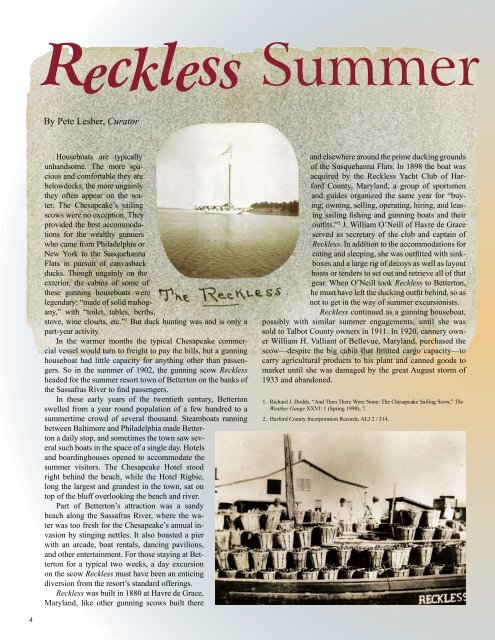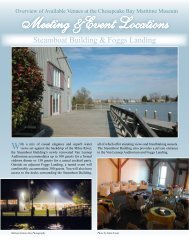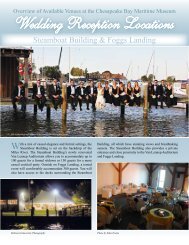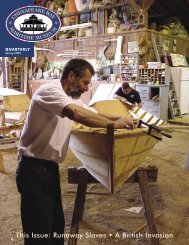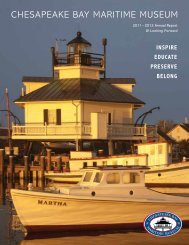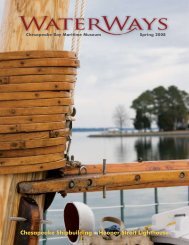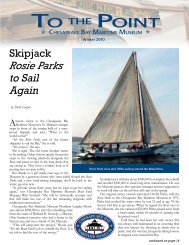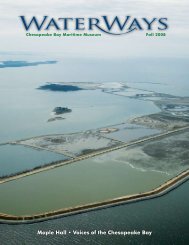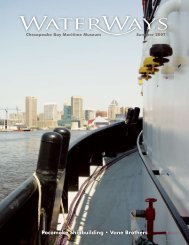The Old Point Restoration ⢠In Search of Shipyards - Chesapeake ...
The Old Point Restoration ⢠In Search of Shipyards - Chesapeake ...
The Old Point Restoration ⢠In Search of Shipyards - Chesapeake ...
Create successful ePaper yourself
Turn your PDF publications into a flip-book with our unique Google optimized e-Paper software.
Reckless Summer<br />
By Pete Lesher, Curator<br />
Houseboats are typically<br />
unhandsome. <strong>The</strong> more spacious<br />
and comfortable they are<br />
belowdecks, the more ungainly<br />
they <strong>of</strong>ten appear on the water.<br />
<strong>The</strong> <strong>Chesapeake</strong>’s sailing<br />
scows were no exception. <strong>The</strong>y<br />
provided the best accommodations<br />
for the wealthy gunners<br />
who came from Philadelphia or<br />
New York to the Susquehanna<br />
Flats in pursuit <strong>of</strong> canvasback<br />
ducks. Though ungainly on the<br />
exterior, the cabins <strong>of</strong> some <strong>of</strong><br />
these gunning houseboats were<br />
legendary: “made <strong>of</strong> solid mahogany,”<br />
with “toilet, tables, berths,<br />
stove, wine closets, etc.” 1 But duck hunting was and is only a<br />
part-year activity.<br />
<strong>In</strong> the warmer months the typical <strong>Chesapeake</strong> commercial<br />
vessel would turn to freight to pay the bills, but a gunning<br />
houseboat had little capacity for anything other than passengers.<br />
So in the summer <strong>of</strong> 1902, the gunning scow Reckless<br />
headed for the summer resort town <strong>of</strong> Betterton on the banks <strong>of</strong><br />
the Sassafras River to find passengers.<br />
<strong>In</strong> these early years <strong>of</strong> the twentieth century, Betterton<br />
swelled from a year round population <strong>of</strong> a few hundred to a<br />
summertime crowd <strong>of</strong> several thousand. Steamboats running<br />
between Baltimore and Philadelphia made Betterton<br />
a daily stop, and sometimes the town saw several<br />
such boats in the space <strong>of</strong> a single day. Hotels<br />
and boardinghouses opened to accommodate the<br />
summer visitors. <strong>The</strong> <strong>Chesapeake</strong> Hotel stood<br />
right behind the beach, while the Hotel Rigbie,<br />
long the largest and grandest in the town, sat on<br />
top <strong>of</strong> the bluff overlooking the beach and river.<br />
Part <strong>of</strong> Betterton’s attraction was a sandy<br />
beach along the Sassafras River, where the water<br />
was too fresh for the <strong>Chesapeake</strong>’s annual invasion<br />
by stinging nettles. It also boasted a pier<br />
with an arcade, boat rentals, dancing pavilions,<br />
and other entertainment. For those staying at Betterton<br />
for a typical two weeks, a day excursion<br />
on the scow Reckless must have been an enticing<br />
diversion from the resort’s standard <strong>of</strong>ferings.<br />
Reckless was built in 1880 at Havre de Grace,<br />
Maryland, like other gunning scows built there<br />
and elsewhere around the prime ducking grounds<br />
<strong>of</strong> the Susquehanna Flats. <strong>In</strong> 1898 the boat was<br />
acquired by the Reckless Yacht Club <strong>of</strong> Harford<br />
County, Maryland, a group <strong>of</strong> sportsmen<br />
and guides organized the same year for “buying,<br />
owning, selling, operating, hiring, and leasing<br />
sailing fishing and gunning boats and their<br />
outfits.” 2 J. William O’Neill <strong>of</strong> Havre de Grace<br />
served as secretary <strong>of</strong> the club and captain <strong>of</strong><br />
Reckless. <strong>In</strong> addition to the accommodations for<br />
eating and sleeping, she was outfitted with sinkboxes<br />
and a large rig <strong>of</strong> decoys as well as layout<br />
boats or tenders to set out and retrieve all <strong>of</strong> that<br />
gear. When O’Neill took Reckless to Betterton,<br />
he must have left the ducking outfit behind, so as<br />
not to get in the way <strong>of</strong> summer excursionists.<br />
Reckless continued as a gunning houseboat,<br />
possibly with similar summer engagements, until she was<br />
sold to Talbot County owners in 1911. <strong>In</strong> 1920, cannery owner<br />
William H. Valliant <strong>of</strong> Bellevue, Maryland, purchased the<br />
scow—despite the big cabin that limited cargo capacity—to<br />
carry agricultural products to his plant and canned goods to<br />
market until she was damaged by the great August storm <strong>of</strong><br />
1933 and abandoned.<br />
1. Richard J. Dodds, “And <strong>The</strong>n <strong>The</strong>re Were None: <strong>The</strong> <strong>Chesapeake</strong> Sailing Scow,” <strong>The</strong><br />
Weather Gauge XXVI: 1 (Spring 1990), 7.<br />
2. Harford County <strong>In</strong>corporation Records, ALJ 2 / 314.<br />
4


